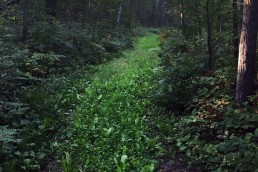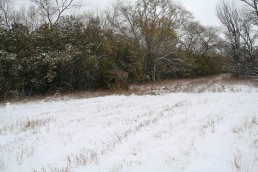How to Plant a Food Plot the Happy, Healthy Way
SHARE THIS POST
For the past 10 years or so I’ve attempted to create small food plots near my home in the Upper Midwest. The primary goal of course was to increase my odds of catching a glimpse of the elusive white-tailed deer from a well-placed treestand in fall. Like many of you, for the most part, I enjoy the challenge of attempting to get plots to grow in often less-than-ideal soils and climate. I’ve had limited access to heavy equipment, creating the majority of my plots with an ATV, backpack sprayer, hand-seeder, and, of course, the proverbial, blood, sweat and tears. I have had successes and failures, but each year I learn something new—when and where to plant, how weeds grow better than anything I plant and why planting a variety of forage is important. I’ve also read articles, watched videos online and have attended food-plot sessions at sports shows. Learning the hard way, and endeavoring to create and maintain food plots, can pose risks. I don’t recall reading anything warning of the possible health hazards one may encounter when establishing food plots. Reducing your risk of the discomfort, injury and unneeded medical expense that can come with growing these plots is important.
Poison ivy, oak and sumac are all plants that you may encounter when clearing an area to plant. After a trip to the local walk-in clinic that resulted in a steroid shot to my backside, I learned that these innocent-looking plants are not to be underestimated. If you’re clearing woodland brush, a meadow or any type of undergrowth, my advice is to assume you’re clearing a plant with sap oil on it that can cause a burning itch and discomfort. Protective clothing, including long sleeves, long socks and pants that cover your skin is a must. Also, wearing knee-high rubber boots and heavy rubber gloves reduces your chances of coming in contact with the plant. The sooner you can wash up after working with these the better. There are various soap products on the market specifically manufactured to help remove the oily residue of the plants that cause a reaction. (A handy tip: bring a squeeze-type water bottle and a bar of Fels-Naptha laundry soap in the woods. Alternating between the water and soap is a quick and effective means of removing any plant toxins that may come in contact with your skin.) Specific areas to wash are your hands, neck, insides of your elbows and the backsides of your knees, as these areas seem to be particularly vulnerable. Once you are back home, be sure to keep your clothes away from your family members. I place them in a separate laundry basket marked “food plot clothes” and then they are washed separately from the other clothes. If you do see a rash that appears a few days after being outdoors you suspect was caused by a trip into the woods, be sure to consider treatment options that can help deal with any delayed acute itch and discomfort.
Besting the bites
Ticks, hornets, mosquitoes, and biting flies are a given foe when venturing into the great outdoors. Depending on the time of the year, these can put a damper on your ability to produce and maintain a food plot.
Lyme disease is a tick-borne disease that the medical community is still trying to understand and treat. It is a disease that is often spread via the bite from a blacklegged tick, or “deer tick.” This tick can spread other diseases, but it is hard to spot (it is roughly the size of pepper flake.) Each year, more and more cases of this disease are diagnosed in the Midwest. According to the Center for Disease Control, Lyme disease cases have tripled in the U.S. over the last two decades. Unfortunately, I live a region where each year a friend or relative is treated or diagnosed with this disease. Below are some tips to reduce your chances of getting a tick.
- Wear light-colored clothing (long pants and sleeves) that makes ticks easier to spot.
- The night before you head to the woods, spray your clothing and boots with a chemical, Permethrin, which can be found at most outdoor product stores. This spray needs to dry on your clothes, but will work wonders in keeping ticks off. Manufactures of this chemical spray warn NOT to spray it directly onto your skin.
- A more expensive option is to purchase clothing (online) that is already treated (built in) with Permethrin.
- A khaki-colored wide brim, safari-type hat works well, as the ticks are easier to spot on these and you protect your face and neck from sunburn at the same time.
- When you’re done with your work in the brush, look yourself over for ticks (get a friend to help, if available) and change into a clean, unused set of clothes before getting into your vehicle to drive home.
- Place work clothes and boots in a heavy plastic trash bag and tie the bag with a knot. I will leave the clothes in the bag in the garage for about a week, and when I open it up I’ve found nothing but dead ticks.
- Shower as soon as you get home. Checking for and quickly removing ticks is key. Using a mirror can help. If you find one, slowly pull it off with a tweezers, but avoid twisting it, as you want to remove all the mouthpiece of a tick.
- Swab the tick bite with a little bit of hydrogen peroxide
- If you suspect the tick may be a deer tick, you can seal the tick in a re-sealable plastic baggie, and, if you wish, you can have it tested to see if it is a carrier of Lyme’s disease.
- Be aware of the signs and symptoms of Lyme disease (bull’s-eye rash, etc.), and if in doubt, head to your local medical provider or physician immediately for diagnosis or treatment.
This one is gonna sting
I once witnessed my buddy Tom, who was walking behind a brush hog we had rented to clear a new plot. Suddenly, I saw him sprint to his truck at a speed that would make Usain Bolt jealous. His arms flailing wildly, I could hear him saying words that would not go over very well in church. He had just encountered a large in-ground hornets nest and managed to get stung a dozen times on his hands and neck. Stinging and biting insects can put a damper on the limited time you’re able to spend working outside. Preparation is key when heading into the wild. My standard gear includes long-sleeved shirts and pants and a bug spray containing at least 25 to 30 percent of DEET. Additionally, I have found that wearing a bug-proof head net can work even if you’re eating ice cream on a hot summer day and the horse or deer flies are biting. If you really want to avoid the bite, a mosquito-proof mesh bug suit (pants and shirt) will keep the pesky biting bugs at bay. For the record, I also keep a couple of the foaming spray cans of hornet/wasp killer in my food plot work toolbox/kit. I know Tom, aka “the hornet,” will do so ever since his encounter.
Are you enjoying this post?
You can be among the first to get the latest info on where to go, what to use and how to use it!
Depending on the type of bite, some treatment tips include these:
- Bee stings are treated best by first removing the stinger, putting an ice pack on the bite, and taking a couple of ibuprofen or acetaminophen.
- For mosquito, deer, or horse fly bites, wash the bites with soap and water then dab a bid of calamine lotion on each bite to alleviate the itch.
- Be sure to have an epinephrine injector at all times if you’re outside a lot and know, if stung, you would suffer a severe allergic reaction to any potential bee sting.
- According to the Cleveland Clinic, and the information offered in their Bee Stings and Bug Bites 10 treatment guide, “Severe allergic reactions are rare, but can be serious” and you should “call 911 or seek immediate medical care if you suspect you are having an unusual reaction.”
Stay thirsty my friend
Getting dehydrated and putting yourself at risk is much more common than most outdoors people realize. Many of you have heard that on average we need to drink at least eight, 8-ounce glasses of fluid a day. However, if you are exerting yourself in the heat and are wearing heavy boots and clothing, you’ll likely need a lot more fluid than what’s typically recommended. If you become dehydrated, you can have changes in your balance, depth perception and judgement. In more severe dehydration cases, increased stress can result on your kidneys and your heart. One of the quick checks you can do is to notice if your urine is darker than a pale yellow. Think “lemonade” color—if it looks more like an IPA beer, then you are likely in need of more fluids.
According to experts at the Mayo Clinic, some tips to avoiding dehydration include:
- For every hour of moderate to heavy physical labor, increase your fluid intake by 2 1/2 glasses.
- If you weigh over 200 pounds you need more liquids than the average person, potentially needing to drink 1 1/2 to 2 gallons a day if working in the heat of the summer.
- If you’re spending more than a couple of hours working, alternate in a sports drink (Gatorade, Power-Ade, etc.) that contains electrolytes, (i.e. salts) with cool water.
- Avoid or limit consuming beverages that can cause the body to dehydrate, including excessive alcohol or caffeine, both that can increase your risk.
- If you notice a headache or begin to feel dizzy or lightheaded, you’re likely experiencing early symptoms that may lead to a more dangerous situation. Stop working. You need to cool down by finding some shade, drinking more fluids and resting until you feel better.
The wrap-up
Improving or shaping the habitat for the wildlife in your area can be a rewarding endeavor, regardless if you enjoy hunting, nature photography, or just observing the critters that stop to nibble. And protecting oneself from the elements of nature and preventing and treating any reactions can be vital.
In my experience, spending additional time and effort in the woods has been a satisfying, off-season pursuit. Whether I’m working on trimming shooting lanes, exploring for a new treestand location or planting and maintaining plots, I have come to appreciate the additional time outdoors away from the traffic, noise and business of everyday life. Just remember, proper planning, having the right clothing, gear, protective equipment and supplies are keys to success. Having the knowledge of the potential health risks that you may encounter working in the wild or when hunting afield can ensure a safe and enjoyable experience.
Did you enjoy this post?
You can be among the first to get the latest info on where to go, what to use and how to use it!

